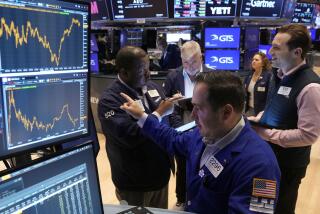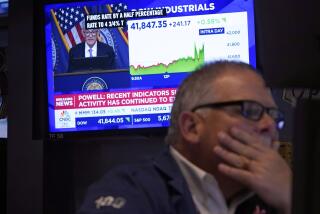THE ECONOMY: JITTERS AMID OPTIMISM : Dow’s Plunge Spurred by Wide Selloff After Fed Move
- Share via
The market’s stunningly negative reaction Friday to the Federal Reserve Board’s interest rate hike was across-the-board, with a wide array of stocks being battered as investors dumped banking and other financial stocks vulnerable to rising interest rates--as well as the recently favored economically sensitive, or cyclical, issues.
The selloff intensified in the afternoon, triggering New York Stock Exchange measures that were adopted after the October, 1987, crash to handle excessive volatility and preserve the public’s faith in the market.
The Dow Jones industrial average closed the day down 96.24 points, or 2.43%, its biggest one-day drop in more than two years. The decline left the average at 3,871.42.
Market veterans noted that although dramatic, the drop in the Dow industrials merely returned the popular blue-chip performance gauge to where it stood in mid-January. For the week, the average retreated 74.01 points.
The Fed’s announcement that it was raising short-term interest rates also sent shock waves through bond and currency markets, sending yields sharply higher in volatile trading and the dollar surging to a 2 1/2-year high against the German mark.
In the broader market, declines swamped advances by more than 6 to 1 on the NYSE, where trading was brisk. Volume amounted to 378.38 million shares on the Big Board, up from 318.35 million on Thursday, making it the busiest session so far this year.
The stock market had the most violent reaction to word that the nation’s central bank decided to nudge up the cost of borrowing for the first time in five years.
Other market indicators mirrored the Dow’s setback. The NYSE composite index shed 5.97 points to 261.21 and lost 4.21 points for the week, while the Standard & Poor’s 500 fell 10.90 points to 469.81 and lost 8.89 points on the week.
Among the other exchanges suffering losses, the Nasdaq composite plunged 20.51 points to 777.28, a 2.57% loss.
The American Stock Exchange index lost 8.89 points to close at 478.29, a 1.82% decline.
Banking and other stocks particularly vulnerable to rising interest rates were hit hard but cyclical issues also took a beating.
Among the market highlights:
* Chemical Bank ended down 1 1/8 to 36 3/4, Citicorp retreated 2 1/4 to 40 1/4, Bankers Trust slipped 1 1/2 to 82 and Kemper lost 1/2 to 41.
* The Big Three auto makers also gave back some of their recent gains. Ford fell 1 3/8 to 68, General Motors shed 1 3/8 to 61 5/8 and Chrysler ended off 1 to 61 1/2.
* Tobacco dealer Universal fell 3 1/8 to 22 after it reported quarterly earnings below analysts’ estimates.
* American Electric Power fell 1 1/8 to 34 1/8 in response to the Fed’s announcement.
* Stone Container dropped 3/8 to 15 1/4 on heavy volume.
* Apple Computer closed unchanged at 33 1/2, Novell fell 7/8 to 21 5/8 and Amgen dropped 1 5/8 at 41 7/8.
* Intel lost 1 1/2 to 61 3/4 and Ivax fell 1/8 to 32.
* Renaissance Communications closed at 20 1/4, above its debut price of 19.
Credit
Short-term Treasury securities’ yields soared and long-term bonds posted smaller gains after the Fed announcement.
The main 30-year bond yield rose to 6.35% from from 6.31% on Thursday. Its price, which moves in the opposite direction, dropped 5/8 point, or $6.25 per $1,000 in face value.
The move jolted the market for government securities and sent interest rates skyrocketing on Treasury bills, the shortest-term maturities and those most directly affected by changes in the federal funds rate.
Prices of short-term Treasuries fell 1/4 point to 13/32 point, while intermediate maturities dropped 17/32 point to 25/32 point, the Telerate Inc. financial information service reported.
The discount rate on three-month Treasury bills rose 0.08 percentage point to 3.21%. Six-month yields jumped to 3.47% as the discount rose 0.11 point to 3.37%. One-year yields shot up to 3.81% as the discount rose 0.07 point to 3.66%.
Other Markets
The dollar benefited from the Fed action and hit its highest level against the German mark in 2 1/2 years. It also rose against other major foreign currencies. Higher interest rates usually strengthen the dollar, since investors earn more on dollar deposits.
The dollar initially softened Friday morning after the Labor Department released its employment report.
But after the Fed announced its monetary policy tightening, the dollar shot back up. Traders said the rise against the Japanese yen was restrained by continuing tension over bilateral trade talks, as well as by dollar selling by Japanese exporters.
In New York, the greenback closed at 1.760 German marks and at 109.25 Japanese yen, up from 1.749 marks and 108.15 yen Thursday.
Meanwhile, precious metal futures prices weakened after the Fed announcement. On the New York Comex, gold closed at $386.60 an ounce, off 70 cents from Thursday, while silver ended at $5.417 an ounce, off 4.8 cents.
Market Roundup, D4
MAIN STORY: The Fed raises the benchmark federal funds rate to 3.25%. A1
REACTION: Investors dump stocks and bonds in a flurry of anxious trading. A1
A Sharp Rise in Rates...
Short-term interest rates surged this week, as the Federal Reserve Board signaled its first official credit-tightening move since 1989. 3-month Treasury bill yield, biweekly: Friday: 3.28%.
Major stock indexes plunged Friday after the Fed announced its rate hike, wiping out much of the market’s strong gains since Jan. 1. Year-to-date change in key market indexes:
Dow Indusrials: +5.7% (as of Thursday), +3.1 (as of Friday)
S&P; 500: +3.1 (as of Thursday), +0.7 (as of Friday)
Nasdaq composite: +2.7 (as of Thursday), +0.1 (as of Friday)
The Dow’s 10 Worst Days
The Dow Jones industrial average had its eighth-worst point drop Friday. Here are the 10 worst days for the average, in terms of points lost, including the percentage change in value.
Date Point change Percent change Oct. 19, 1987 -508.00 to 1,738.74 22.6% Oct. 13, 1989 -190.58 to 2,569.26 6.9% Oct. 26, 1987 -156.83 to 1,793.93 8.4% Jan, 8, 1988 -140.58 to 1,911.31 6/9% Nov. 15, 1991 -120.31 to 2,943.20 3.9% Oct. 16, 1987 -108.35 to 2,246.74 4.6% April 14, 1988 -101.46 to 2,005.64 4.8% Feb. 4, 1994 -96.24 to 3,871.42 2.4% Oct. 14, 1987 -95.46 to 2,412.70 3.8% Aug. 6, 1990 -93.31 to 2,716.34 3.3%
Source: Bloomberg Business News, Associated Press
DAILY DIARY
Dow Jones Industrials:
High: 3,979.76
Close: 3,871.42
Low: 3,857.63
New York Volume: 378.38 million shares
Interest Rates:
30-year T-Bond: 6.35%
1-year T-Bill: 3.81%
More to Read
Inside the business of entertainment
The Wide Shot brings you news, analysis and insights on everything from streaming wars to production — and what it all means for the future.
You may occasionally receive promotional content from the Los Angeles Times.










